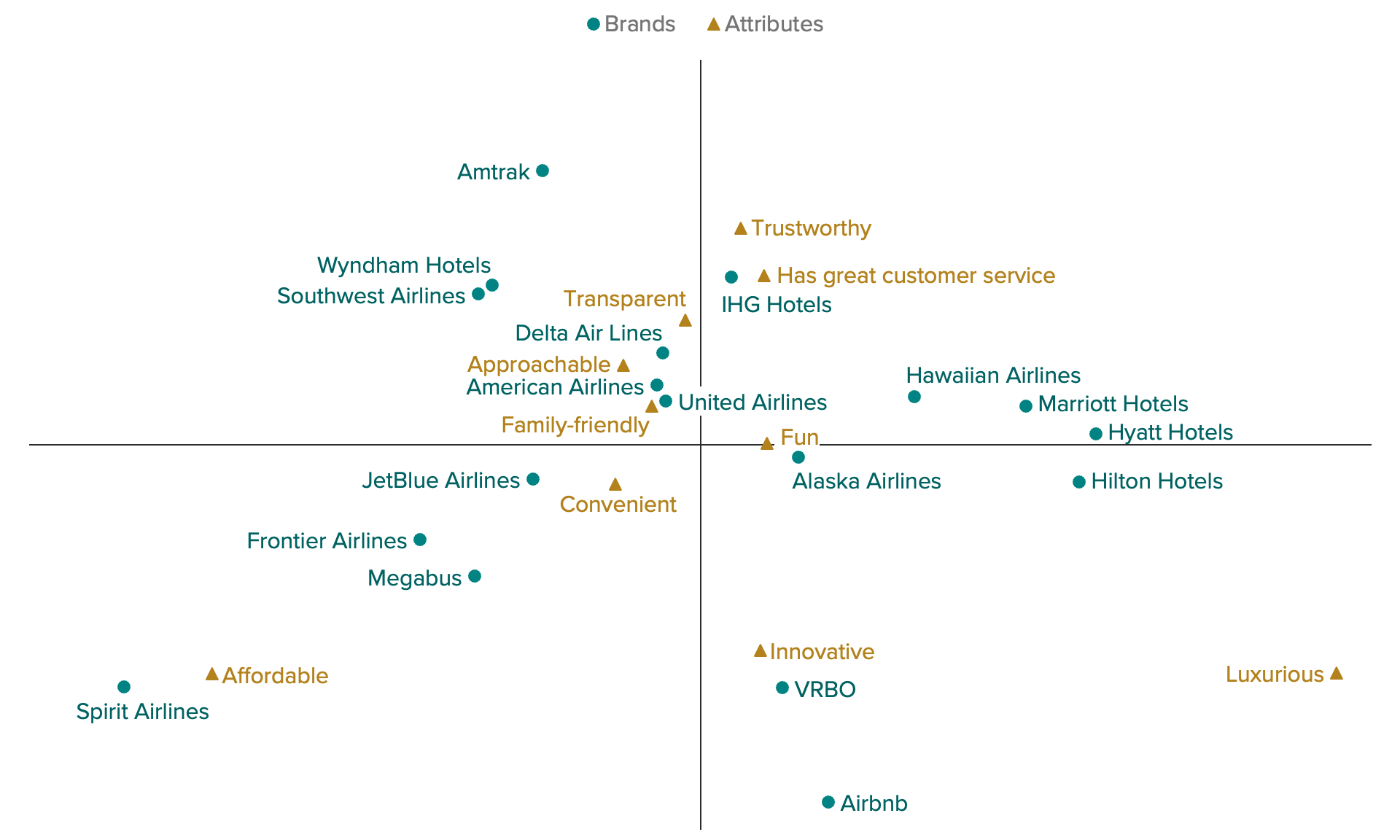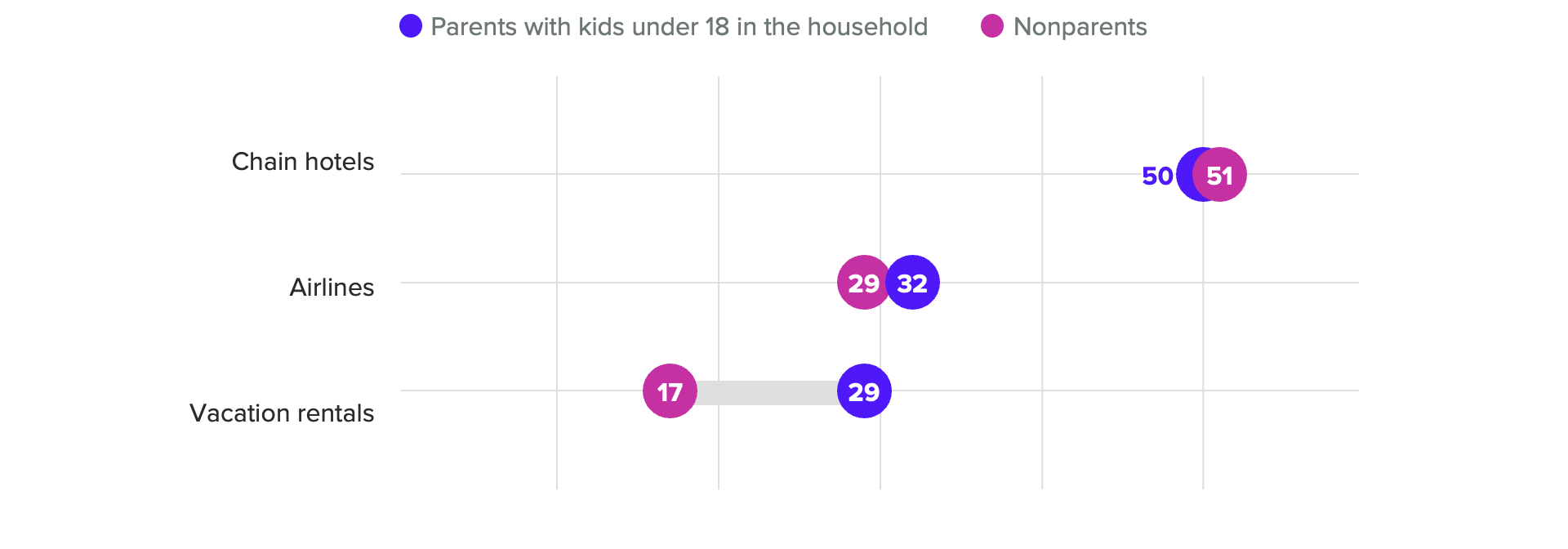Families Aren’t Getting What They Need From Travel Brands

Families who travel look to companies to help ensure their trips go smoothly, but no major brand in the industry is currently defined by consumers as uniquely family-friendly. Travel companies can differentiate themselves by providing tailored support for this sizable audience.
This is part of Morning Consult’s upcoming family travel report, Are We There Yet?, which uncovers the barriers and unmet needs of traveling families and the opportunities for brands to address them. It is scheduled to publish on Nov. 17.
Family travelers are an important and underserved audience. They experience unique challenges and barriers while planning, preparing for and taking trips, which either force them to do extra work to find their own solutions or ultimately deter them from traveling altogether.
When families do stay home, travel brands are missing out on a significant source of revenue — past research has estimated that family travel accounts for 35% of all domestic travel in the United States and that families spend more while they’re on the road than those traveling without children.
To connect with families and encourage them to travel, brands in the industry must understand the barriers they face and develop products and services tailored toward making the experience easier from start to finish.
Family-friendliness is an unowned attribute among travel brands
Families who travel encounter various brands throughout their experience, most notably in the transportation and accommodation spaces. But a recent Morning Consult correspondence analysis reveals that none of the major players in those sectors stand out as the go-to brand for traveling families.
Correspondence maps show in one chart what would otherwise take many: how similar brands are to one another in consumers’ minds across many attributes, how closely they are associated with certain attributes and where there is white space for brands to differentiate themselves further.

From a list of 19 travel and hospitality brands, respondents were asked how well up to four brands they had an opinion on (whether positive or negative) embodied 10 attributes. The extent to which people believed the attribute applied to each brand was then used to power a correspondence analysis to see how the brands related to one another across the 10 attributes, and to what degree each brand was defined by a set of attributes. (Bolt Bus was removed from the correspondence analysis due to respondents more commonly having no opinion or low awareness of this brand, which resulted in a lower sample size.)
There is a push and pull to the connection between attributes and brands that leads to the arrangement of brands and attributes across the map. The farther away brands are from other brands, or the farther away the attributes are from other attributes, the more differentiated the brands or differentiating the attributes. The angle between each brand, attribute and the origin of the map (the intersection of the x and y axes) shows how closely consumers connect the brand and attribute, with smaller angles indicating a closer correspondence.
In this case, for example, Airbnb and VRBO are highly differentiated from other brands on the attribute of innovation. Similarly, Spirit is differentiated due its unique relationship with affordability, although JetBlue, Frontier and Megabus are also perceived to be affordable given the small angle between each brand, the origin and the attribute.
The placement of family-friendliness on the map is notable, as it is among the closest to the origin, suggesting that it’s not a characteristic that is truly differentiating for the brands measured. In other words, no one travel brand is “owning” the position of being family-friendly. The brand closest to doing so is Southwest Airlines, for whom the angle between the brand, the attribute of family-friendliness and the origin is very small. However, even for Southwest, only slightly more than a third of consumers strongly agree that it can be described as family-friendly.
For companies in the space, this equates to a big opportunity. Parents take as many annual trips with their kids on average as U.S. adults do in general, so brands that win their favor stand to gain significant revenue. Being the go-to travel company for planning parents should be a North Star for travel brands looking to differentiate themselves and connect with this audience.
Airlines have the most room for improvement when it comes to serving families
The good news for brands in the travel & hospitality sector is that they’re generally considered more family-friendly than any other characteristic, including affordable, innovative or luxurious. The bad news is that the share of U.S. adults who say travel brands are family-friendly in general is low.
When averaging responses across the most well-known brands measured within each sector, only 26% of consumers strongly agreed that airlines are family-friendly. The story is slightly better for vacation rental brands and chain hotels, but only 31% and 36% said the same about them, respectively.
When it comes to airlines, the lower perception of family-friendliness may be driven in part by the fact that air travel in itself can be intimidating for families — keeping kids entertained and happy in a confined space for an extended time is no easy task.
But parents also experience challenges in air travel that are solvable by airlines. For example, one thing nearly all parents agreed would be desirable when they book airfare is the ability to reserve seats together without paying extra. An airline that automatically seated families together at booking could stand out and win favor among this group.
Vacation rentals offer families an experience that many hotels aren’t
Chain hotels enjoy, on average, the highest level of favorability of all sectors among parents and nonparents alike. However, they also represent the only sector with a slightly higher average favorability among nonparents than parents. What’s more, hotels’ direct competitors — short-term vacation rental companies like Airbnb and VRBO — appeal much more to parents than they do to nonparents.

From time to time, a thread goes viral on social media, started by someone complaining about the hidden fees or cleaning requirements at vacation rentals, generating response after response from travelers saying they’d rather just stay at a hotel. But for parents, the space and amenities they can find at a vacation rental outweigh the downsides.
Kitchen amenities are especially important to traveling families, but they also see value in having outdoor space, separate areas for sleeping and socializing, and access to laundry facilities. Until hotels are able to replicate these offerings for families, vacation rentals will continue to be uniquely beneficial to this group.
Lindsey Roeschke is an analyst whose work focuses on behavior and expectations of consumers in the travel & hospitality and food & beverage categories, particularly through a generational and cultural lens. Prior to joining Morning Consult, she served as a director of consumer and culture analysis at Gartner. In addition to her research and advisory background, Lindsey has more than a decade of experience in the advertising world. She has lived and worked in seven cities across four continents.